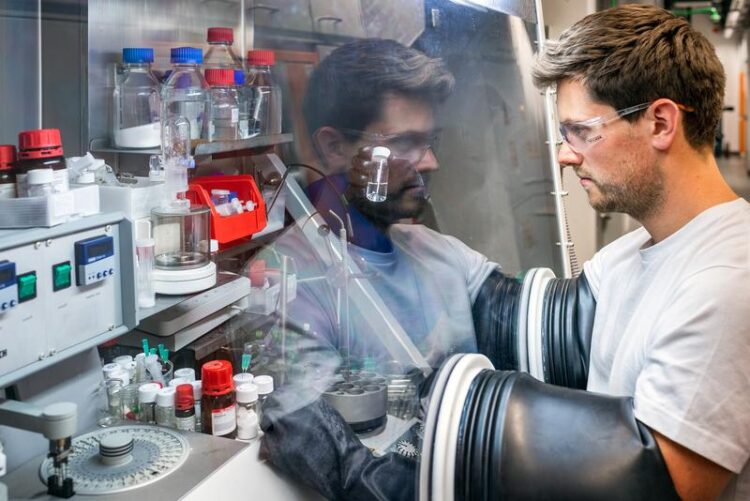Precious metal-free silicone curing

Matthias Nobis in the laboratory of the WACKER-Institute of Silicon Chemistry at the Department of Chemistry on the Garching campus.
Andreas Heddergott / TUM
Sustainable processes could replace valuable metals in silicone crosslinking.
Silicones are tried and tested in the private and professional domains. In many applications, however, expensive precious metals are required as catalysts to transform the liquid intermediate products to durable elastic polymers. A research team from the Technical University of Munich (TUM) and the Munich-based WACKER Group has now developed a curing process that works without precious metals.
Silicones are synthetic polymers consisting of an inorganic silicon-oxygen backbone modified with organic side groups Before use, silicone must be converted to a rubber-elastic state through chemical crosslinking. One of the more important methods used in the industry is addition-curing, since this crosslinking process does not release any volatile byproducts and results in particularly high-quality silicone elastomers.
The process does have one disadvantage, however: the catalysts required for crosslinking contain precious metals such as platinum, which make the manufacturing process relatively expensive. These metals also remain in the silicone permanently.
Rings under strain replace precious metals
A research team headed by Professor Bernhard Rieger, who holds the WACKER Chair of Macromolecular Chemistry, and Dr. Richard Weidner, responsible for the organosilicon research at the Consortium for the Electrochemical Industry, the central research facility of the WACKER Group, has now found a promising approach to resolving this issue.
For the first time ever, the team successfully cured silicone rubber without using precious-metal catalysts. Rather than working with standard crosslinkers, the scientists used silicone building blocks with silirane units.
Siliranes are three-membered rings with a high degree of ring strain, which makes them reactive. The rings comprise one silicon atom and two carbon atoms, and can either react directly, upon ring-opening, with suitable functional groups – without releasing any byproducts – or generate what are known as silylenes through thermal or photochemical activation.
These highly reactive compounds can, in turn, react with any functional groups or synthetic building blocks typically used in the production of silicone rubber. Depending on the type of activation process and the choice of starting compounds, the method opens up a variety of pathways for curing silicones with silirane-containing crosslinkers.
High purity
Using selected silicone formulations the researchers at the WACKER Institute were able to demonstrate in the lab that the method can be used for crosslinking silicone rubber in this manner. The final properties are determined exclusively by the selection of starting products and their mixing ratio.
The silicone elastomers produced in this way are characterized by their exceptional purity. They contain neither volatile substances nor traces of precious metals. “That’s especially true for elastomers, which are crosslinked via a ring-opening reaction. Silicones like these are particularly suitable for medical applications or as encapsulants for the electronics industry,” says Bernhard Rieger.
Sustainable process
What makes this a trailblazing paper is that, for the first time, it shows, in principle, a way of making such highly reactive silicon compounds useful for industrial application. The researchers have to overcome a few more hurdles, however, to demonstrate practical viability in industrial use.
“But we can already clearly see the advantages of the method”, Rieger notes. “Given the global growth in demand for precious metals, which are only available in limited quantities, alternative concepts like the use of siliranes to crosslink silicone without precious metals could play an important role in protecting important resources.”
The research was funded by Wacker Chemie AG as part of the WACKER Institute for Silicon Chemistry. The institute, located on the Garching research campus near Munich, was founded in 2006 by the Technical University of Munich and the Munich-based chemical company WACKER. Since then, 54 researchers at the institute have received their doctorates. Currently, eleven scientists are researching industrially relevant organosilicon topics as part of their doctoral theses. A patent application has been filed for the technology.
Wissenschaftliche Ansprechpartner:
Prof. Dr. Bernhard Rieger
WACKER-Chair of Macromolecular Chemistry
Technical University of Munich
Lichtenbergstr. 4, 85748 Garching, Germany
Tel.: +49 89 289 13571 – E-Mail: rieger@tum.de
Originalpublikation:
Fabian A. D. Herz, Matthias Nobis, Daniel Wendel, Philipp Pahl, Philipp J. Altmann, Jan Tillmann, Richard Weidner, Shigeyoshi Inoue and Bernhard Rieger
Application of multifunctional silylenes and siliranes as universal crosslinkers for metal-free curing of silicones
Green Chem., 2020, 22, 4489-4497
Weitere Informationen:
https://pubs.rsc.org/en/content/articlelanding/2020/GC/D0GC00272K#!divAbstract Original publication
https://www.tum.de/nc/en/about-tum/news/press-releases/details/36334/ Press release on TUM-website
https://www.department.ch.tum.de/en/makro/ Website of the Wacker-Chair of Macromolecular Chemistry
Media Contact
All latest news from the category: Process Engineering
This special field revolves around processes for modifying material properties (milling, cooling), composition (filtration, distillation) and type (oxidation, hydration).
Valuable information is available on a broad range of technologies including material separation, laser processes, measuring techniques and robot engineering in addition to testing methods and coating and materials analysis processes.
Newest articles

Innovative 3D printed scaffolds offer new hope for bone healing
Researchers at the Institute for Bioengineering of Catalonia have developed novel 3D printed PLA-CaP scaffolds that promote blood vessel formation, ensuring better healing and regeneration of bone tissue. Bone is…

The surprising role of gut infection in Alzheimer’s disease
ASU- and Banner Alzheimer’s Institute-led study implicates link between a common virus and the disease, which travels from the gut to the brain and may be a target for antiviral…

Molecular gardening: New enzymes discovered for protein modification pruning
How deubiquitinases USP53 and USP54 cleave long polyubiquitin chains and how the former is linked to liver disease in children. Deubiquitinases (DUBs) are enzymes used by cells to trim protein…



